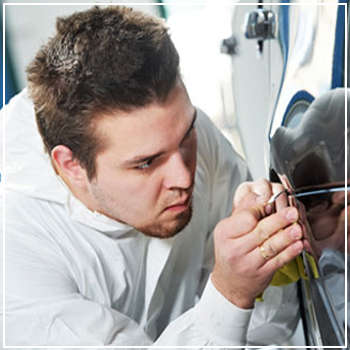 Car lovers and DIYers often grab a paint kit from the auto store to give their vehicles a fresh look. However, over time, issues like rust, bubbles, or dents can appear on the surface. Painting over the same area again won’t fix the problem — it might even make it worse.
Car lovers and DIYers often grab a paint kit from the auto store to give their vehicles a fresh look. However, over time, issues like rust, bubbles, or dents can appear on the surface. Painting over the same area again won’t fix the problem — it might even make it worse.
A professional paint job, especially in a controlled spray booth, can prevent these headaches and ensure your car looks great for years. But what happens if you skip a repaint or do it yourself improperly?
Bleeding
Bleeding occurs when the old paint shows through the new coat, creating a mottled or uneven appearance. This usually happens if the previous layer wasn’t properly sanded or if the new color is too light. To avoid this, always sand the old finish and apply a primer before painting over it.
Die Back or Dulling
Over time, your car’s shiny paint may start to lose its luster and become dull. This is more likely if you don’t reapply the topcoat regularly. Poor solvent evaporation or improper curing of the first coat can speed up this process, making your car look older than it is.
Dirt & Debris
When you paint outside, tiny particles like dust and dirt can settle on the wet paint, causing an uneven, gritty finish. A closed spray booth helps keep the environment clean, reducing the risk of these imperfections.
Air Trapping
Small bubbles that pop while painting can lead to “fish eyes†— a bumpy texture on the surface. This often happens if the car isn’t cleaned properly, if there's leftover wax, or if the spray equipment has contamination. Always make sure your surface is clean and your tools are in good condition.
Orange Peel
Orange peel refers to a rough, bumpy texture that resembles the skin of an orange. It typically happens when the paint dries too quickly before it can smooth out. Factors like incorrect paint gun settings, extreme temperatures, or poor drying between coats can cause this issue.
Running and Sagging
If you apply too much paint at once, it can drip down the sides of the car, leading to uneven coverage. This is common when the base coat isn’t fully dry, the spray gun is too close to the surface, or you’re painting in cold weather.
Fading
Parking your car in direct sunlight without proper protection can cause the paint to fade over time. Regular washing and waxing help preserve the finish and protect it from UV damage.
Wrinkling
Wrinkling, also known as “lifting,†happens when the new paint shrivels or bunches up. This often occurs if the previous coat isn’t fully dry or if the solvents in the new paint repel those in the old one. Proper drying time is essential to avoid this.
Edge Mapping
This issue happens when the solvent from the new paint seeps into the undercoats, causing wrinkling around the edges. Using low-quality primers or sealers can increase the risk of this happening.
Cracks or Crow’s Feet
Cracks or “crow’s feet†form when a coat is too thick or when too much hardener is used. If there were existing cracks, they might show through the new paint. Always follow the manufacturer’s instructions for mixing and application.
Peeling
Like with house paint, if the layers don’t dry properly, they can start to peel off. This is often due to poor adhesion, which can be caused by not letting each coat dry completely or using low-quality materials.
Mottling
Mottling is a streaky or uneven appearance, especially in metallic finishes. It can happen due to unbalanced spray patterns, incorrect gun angles, thin lower coats, or not allowing enough time between coats.
If your car’s paint is looking rough, faded, or uneven, it’s best to seek professional help. Call DaSilva’s Auto Body today and let the experts restore your vehicle’s shine and protect its value for years to come!
Hot-Dip Galvanized Flat Steel,Hot Dip Galvanized Flat Steel,Hot Dipped Galvanized Flat Bar,Hot Dipped Galvanized Steel Plate
TIANJIN JIAYI STEEL CO.LTD , https://www.jiayisteel.com